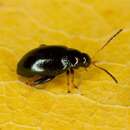en
names in breadcrumbs


Aphthona is a genus of beetle, in the leaf beetle family Chrysomelidae, native to Europe and Asia. More specifically, Aphthona are flea beetles, meaning they have enlarged hind legs for jumping away from potential danger. There are some 300 species known worldwide.[2]
This flea beetle genus is important because of the usefulness of some species in controlling leafy spurge, a major invasive weed in parts of western North America. Several Aphthona species have been taken from Europe and introduced into localized areas of the United States and Canada, and some success against the weed is being seen.[3][4] The six species used for this purpose include A. abdominalis, A. cyparissiae, A. czwalinae, A. flava, A. nigriscutis, and A. lacertosa, though A. abdominalis apparently never established a viable population and was never introduced in Canada.[5][6][7]
Control is generally thought to be effective, but results vary from site to site, which has been attributed to soilborne pathogens, phenology of spring, soil texture, and leafy spurge density. Control is less effective in sandy soils.[8] Control may not be reliably observed and measured for 10 years or more.
Aphthona is a genus of beetle, in the leaf beetle family Chrysomelidae, native to Europe and Asia. More specifically, Aphthona are flea beetles, meaning they have enlarged hind legs for jumping away from potential danger. There are some 300 species known worldwide.
This flea beetle genus is important because of the usefulness of some species in controlling leafy spurge, a major invasive weed in parts of western North America. Several Aphthona species have been taken from Europe and introduced into localized areas of the United States and Canada, and some success against the weed is being seen. The six species used for this purpose include A. abdominalis, A. cyparissiae, A. czwalinae, A. flava, A. nigriscutis, and A. lacertosa, though A. abdominalis apparently never established a viable population and was never introduced in Canada.